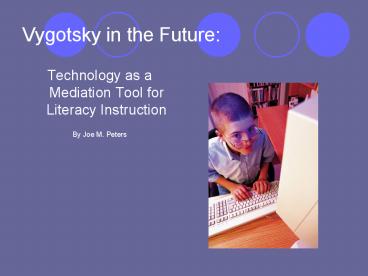Vygotsky in the Future: - PowerPoint PPT Presentation
1 / 13
Title:
Vygotsky in the Future:
Description:
Behaviorists used Teaching Machines in the 1950s to provide individualized ... Gopher/Mosaic. Gopher has become obsolete (requires the user to have software) ... – PowerPoint PPT presentation
Number of Views:62
Avg rating:3.0/5.0
Title: Vygotsky in the Future:
1
Vygotsky in the Future
- Technology as a Mediation Tool for Literacy
Instruction - By Joe M. Peters
2
(No Transcript)
3
Early Computers
- Behaviorists used Teaching Machines in the 1950s
to provide individualized instruction where a
student could not progress without correct
answers - Used primarily as a reinforcement tool
4
The Cognitive Science Paradigm Shift
- The focus of learning theory shifted from
observing behavior based on the environment and
exclusive of the mind, society or thought process
(behaviorism) - Cognitive scientists now viewed the individual as
a complex organism - Neuroscience, anthropology, psychology,
philosophy, linguistics and artificial
intelligence now a part of learning theory
- The development of the microcomputer in the 1970s
brought the development of software - Word and number recognition games
- Drill and practice routines
- Tutorial activities
- Games
- Word identification
- Computerized simulations
5
Multimedia
- The combination of text, clip art, freehand
graphics, animation, movie clips, sounds and
control buttons. - Multimedia, also known as Hypermedia, is
interactive and allows the student to choose
his/her own nonlinear path matching her learning
experience to her own prior knowledge, interests
and capabilities
6
Multimedia and Programming
- Cognitive scientists believe that the more ways
in which information enters the brain the higher
the chance that learning will be internalized
into long-term memory. - Kinetic (actively doing)
- visual and audio reinforcement
- Learning takes on a recognizable personal
purpose. Students are internalizing rather than
memorizing through drills. - Students learn the language and symbol system
- Learning is truly individualized and coherent to
the student
7
Interactive Compact Disk
- Brings the world into the classroom
- Interactive Encyclopedias
- Interactive dictionaries
- walk around nature reserves
- tour a museum
8
Desktop Publishing
- Allows the collaboration of multiple authors
- Writing is more memorable because students are
creating a published work - Students are more motivated to learn the
mechanics of writing when they know that others
will be reading it
9
Internet
- An ever-expanding web of databases that
enables access to text, pictures, video and audio
clips, software, and online discussions. - If the information is out of a students range
of independent ability, students can search for
other related information to mediate
understanding.
10
Tools of the Internet
- E-mail (Simple Mail Transfer Protocol, SMTP)
- provides real-world application for student
writing - File Sharing (File Transfer Protocol, FTP)
- Access to public information on remote computers
(iTunes) - Listserv
- Facilitates mail exchange between large groups
with similar interests - Usenet
- Message boards
- Gopher/Mosaic
- Gopher has become obsolete (requires the user to
have software) - Mosaic is what Netscape and subsequent search
engines are based on
11
Presentation Software
- Programs like Power Point can become
critical scaffolding tools. - More efficient than writing notes on the board or
providing handouts - Incorporate sound and images to reinforce points
- Helps the teacher to organize a lesson and model
how to organize information - Can also be used by students
12
Technology in the Classroom
- Teacher vs. Student-centered learning
- teacher becomes guide/facilitator rather than the
one in charge. - Students are empowered to take responsibility for
their own learning - Technology is often viewed as a remediation tool,
a gifted extra, or a babysitter for students
who finish earlier or teachers who do not want to
teach. - Until this mentality changes, taxpayers, parents,
administrators and politicians will not justify
the allocation of funds for up to date and
functioning technology. - The current classroom, without technology, is an
artificial and inefficient learning environment
that is out of synch with the rest of society.
If we are going to fix the crisis of education,
we must start with technology.
13
Discussion Questions
- Do you agree that technology is the best way to
fix the problem of student achievement in
education today? - What could be some possible drawbacks to
technology in the classroom? - What are some ways that we could change the bias
against technology in our schools?































